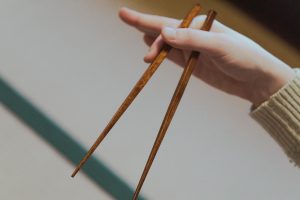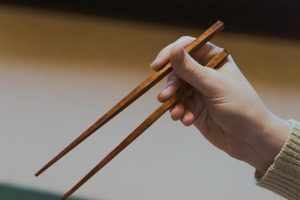
My parents are not adventurous eaters.
Growing up, my family lived off of the same true-blue American dinners every week – mac and cheese, lasagna, burgers that my dad cooked on his trusty old grill in the backyard. My mother brought us up on the two staple fruits: apples and bananas. Grapes were an exotic commodity, and I distinctly remember trying my first strawberry at the age of twelve while visiting a friend’s house.
Sometimes, my mother’s adventurous spirit would be tickled, usually after watching one too many of those survivor TV shows on the Discovery Channel. She would watch those daring men exploring the arctic tundra of Alaska or the tropical rainforests of the Amazon and would be seized with the rare desire to do something bold, something crazy, something spontaneous. This was usually how we ended up with the occasional salmon entree on our dinner menu.
Now, you must understand, my dad hates fish.
When people use the word “hate,” the old adage, “‘hate’ is a strong word,” often comes to mind. However, the opposite is true when it comes to my father and his aversion to fish; hate is not anywhere near strong enough a word to describe it.
When my mom got around to cooking the above-mentioned salmon, my father would hide out in the basement like it was the Cold War and there had been a recent bomb warning. Seriously, if we had had a gas mask at our disposal, he probably would have worn it. He hates the smell of fish that much. For hours after the offending fish had been consumed, he would routinely get out a can of Febreeze and take to the house like a madman trying to kill a hive of bees with pesticide.
So, it’s no wonder that I never had the chance to eat sushi before coming to Japan. Sushi was (obviously) too fishy and too exotic to register on my parents’ tastebuds. I was much more willing to try new things than they were, however. I was eager to experience Japan to its full capacity – which included trying the famously fresh sushi at Tsukiji Market.
But, I found myself in a bit of a predicament. Besides being a foreigner in Japan, I was at a loss as to how to actually eat the sushi. How was I supposed to use these two sticks to get this delicious looking food into my mouth? I had limited experience with chopsticks since my parents much preferred to eat out at the Old Country Buffet instead of getting Chinese take-out, and I wished I knew how to better go about it.
Lots of restaurants in touristy locations will kindly provide forks for Foreigners to use if asked, and some Japanese foods, such as curry, are actually exclusively eaten with “Western” eating utensils like the spoon. However, there are just some foods that you cannot pull the gaijin card with and use a fork. Sushi is one of them. That being said, let’s go over how to properly use chopsticks so that you don’t have to struggle with them the way I did.
How to Use Chopsticks
Most foreigners (like me) are game for trying to use chopsticks, but our enthusiasm quickly dies upon the realization that it’s not as easy as it looks. Even now, after living in Japan for three years, there are times when I still struggle to get that mouth-watering food from my plate into my mouth – a distance that doesn’t seem that large until I have chopsticks in my hands.
I have seen some Westerners get so desperate that they give up all pretense of politeness in favor of harpooning their food. Please, don’t do this, as tempting as it may be. It would be like eating a salad with your fingers; it’s just not good table manners. If you worry that using chopsticks might be difficult for you, get your hands on a cheap set and practice at home before going out to a public restaurant.
Here are some simple steps to help you get the hang of using them correctly:
Step One: Hold your hand out as if you are going to shake someone’s hand.
Step Two: Take one chopstick and place it under your thumb, with it resting on your palm.
Step Three: Place the other chopstick between your thumb and forefinger.
Step Four: Bend your ring finger and tuck it under the bottom chopstick.
Step Five: Place your middle finger under the top stick.
Step Six: Move the top stick up and down to grab food.
Pro Tip: Hold your chopsticks towards their back end, not in the middle or the front third. This will make them much easier to use.
Waribashi
Now that you know how to use chopsticks, let’s go over some things you should not do with them. Many restaurants in Japan will provide you with a pair of wooden chopsticks that need to be broken apart called, waribashi (割り箸). Some people will break open their chopsticks and rub them together to get rid of splinters – I know that’s I what I did when I first came to Japan. I thought that it made me look fancier, kind of like how swirling your wine glass makes it look like you know more about the wine you’re drinking than you really do. Do not be fooled like I was. All it does is show the restaurant owners and those with whom you are dining with that you believe the chopsticks (as well as the establishment you are eating at) are cheap.
Funerals and Chopsticks
You might be wondering what funerals and eating with chopsticks have to do with one another. Surprisingly, they have more in common than you might think and if you want to avoid committing some major faux pas in Japan, it’s good to become acquainted with a few cultural points concerning the two.
When somebody dies in Japan, their bodies are cremated in a special ceremony where relatives pick the deceased’s bones out of the ashes and place them in an urn using long chopsticks. During this funeral rite, it is not uncommon for two family members to hold the same bone at the same time with their chopsticks. They might even pass the bones from one pair of chopsticks to another.
As such, when you are out eating with friends, you should never transfer food from your chopsticks to theirs because it reminds the Japanese of a funeral. And there’s really no better way to lose your appetite than by thinking about old Grandpa’s human remains.
The biggest etiquette taboo, though, is called tsukitate-bashi (突き立て箸), which is when you stick your chopsticks straight up in a bowl of rice. How does this connect to funerals, you might ask? Well, at Japanese funerals, a bowl of rice is left with two chopsticks standing up vertically in the center. It is a universal symbol of death is said to bring bad luck.
In any case, learning to eat in Japan is just that – something you must learn. Don’t get too discouraged if you make some mistakes. The Japanese people are very kind and considerate, and will almost never call you out on your mistakes. Just keep at it and enjoy the experience of eating traditional Japanese cuisine.







